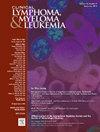Real-World Effectiveness of Chemoimmunotherapy and Novel Therapies for Patients With Relapsed/Refractory Aggressive Large B-Cell Lymphoma
IF 2.7
4区 医学
Q2 HEMATOLOGY
引用次数: 0
Abstract
Introduction
Clinical trials provide meaningful data regarding the safety and efficacy of novel therapies but there is often a lag between the time of new drug approval and information on posttreatment clinical outcomes in real-world practice. This study evaluated clinical outcomes in a large real-world population of patients with relapsed and/or refractory large B-cell lymphoma (r/r LBCL) treated with chemoimmunotherapy or novel therapies in second or later lines of therapy (2L+).
Materials and Methods
Data from the Lymphoma Epidemiology of Outcomes (LEO) Consortium of Real-World Evidence (CReWE) cohort (1/1/2015–2/15/2023) were analyzed. Patients’ demographic and clinical characteristics were described and response rates, duration of response, progression-free survival, and overall survival were evaluated. Multivariable Cox proportional hazards regression models were used to assess associations between patient clinical characteristics and outcomes.
Results
The 2L+ cohort included patients treated with chemoimmunotherapy (N = 593), lenalidomide-based therapy (n = 60), polatuzumab vedotin-based therapy (N = 116), tafasitamab-based therapy (N = 55), and loncastuximab tesirine (N = 42). Most patients who received prior chimeric antigen receptor T-cell therapy (CAR-T) were refractory to the treatment. Across all patients, overall response rates were <50%, with one-quarter achieving complete response and median duration of response and overall survival were short (<6 and <10 months, respectively) among patients treated with chemoimmunotherapy or novel therapies. The prognosis was worse for patients who had previously received CAR-T. Primary refractory status, high-risk disease, and failing 3 or more lines of therapy were significantly associated with worse outcomes.
Conclusion
Patients with r/r LBCL have unfavorable outcomes and need more effective treatment alternatives.
求助全文
约1分钟内获得全文
求助全文
来源期刊

Clinical Lymphoma, Myeloma & Leukemia
ONCOLOGY-HEMATOLOGY
CiteScore
2.70
自引率
3.70%
发文量
1606
审稿时长
26 days
期刊介绍:
Clinical Lymphoma, Myeloma & Leukemia is a peer-reviewed monthly journal that publishes original articles describing various aspects of clinical and translational research of lymphoma, myeloma and leukemia. Clinical Lymphoma, Myeloma & Leukemia is devoted to articles on detection, diagnosis, prevention, and treatment of lymphoma, myeloma, leukemia and related disorders including macroglobulinemia, amyloidosis, and plasma-cell dyscrasias. The main emphasis is on recent scientific developments in all areas related to lymphoma, myeloma and leukemia. Specific areas of interest include clinical research and mechanistic approaches; drug sensitivity and resistance; gene and antisense therapy; pathology, markers, and prognostic indicators; chemoprevention strategies; multimodality therapy; and integration of various approaches.
 求助内容:
求助内容: 应助结果提醒方式:
应助结果提醒方式:


